*This post may contain affiliate links. Read more »
I think I finally cracked the code for perfect Bihun Goreng. In English, this Indonesian delight translates to "Fried Rice Vermicelli." Made right, it’s a delicately balanced mash-up of flavors, colors, and textures. Made wrong, it’s just a sad, sad day in noodle town. But what we are doing here is making this dish perfectly together, ’cause I love ya!


Enter your email & I'll send it to your inbox. Plus, get great new recipes from me every week!
By submitting this form, you consent to receive emails from Cinnamon Snail.
Originating from the bustling streets of Indonesia and spreading like a noodle-virus to Malaysia and Singapore, where it’s sometimes called Bee Hoon Goreng, as well as Mi Hun Goreng, the dish is a crowd-pleaser for too many reasons to list. The beauty of Bihun Goreng lies not only in its taste but also in its simplicity, and how quick and easy it is to make. It works as a perfect accompaniment to sambal goreng, tahu goreng, and even miso glazed eggplant with pickled green chilies.
💣And here's the best part: You're about to unlock the secrets to crafting this glorius flavorful bomb, once and for all. My step-by-step instructions will help you knock it out of the park without any common missteps people make, resulting in bland noodles that reach the plate falling apart.
This is a dish that takes less than 30 minutes to make and is sure to become a favorite in your house. Let's start stir-frying and savoring the flavors of Bihun Goreng together!
Jump to:
🥰Why you'll adore this bihun gorgeng recipe:
✊Vegan AF: Like all of my vegan Indonesian recipes, this Bihun Goreng brings the flavor like a son-of-a-gun without harming animals. You know what else? It’s also a completely gluten-free vegan recipe too!
🥸Fool-proof Method: With precise instructions, and a recipe that has been tested a bazillion different ways, you'll conquer Mi Hun Goreng on your very first try.
😸Quick as a Cat: Craving some delightful freaking noodles in a flash? From prep to plate in less than half an hour, the good news is you can make this more than 48 times a day, and still have time to eat the darn stuff!
✅ Tested and Approved Worldwide: Like all of my vegan recipes, this one’s been fine-tuned to perfection and put to the test by a dedicated group of recipe testers across the globe, including in Indonesia. You're guaranteed a delightful outcome wherever you are on the planet because I took the time and care to ensure it.


Warning: This Will Transform Your Vegan Indo Cooking!
This 6-day plant-based deep dive into the vibrant cuisine of Indonesia is 100% FREE.
🌶️ Ingredients for bihun goreng

Rice Vermicelli
These super-thin rice noodles are a staple in Asian cuisine. They're gluten-free and provide a light, delicate texture to the dish. In Bihun Goreng, they soak up the flavorful sauces and spices, creating a satisfying bite in every mouthful. If you're out of rice vermicelli, you can substitute with mung bean noodles (same as what you might use to make pad woon sen) or even a mix of ramen noodles and thicker rice noodles, like you might use to make curry laksa.
Sambal Oelek
This sorta medium-fiery chili paste that brings a flavorful little punch of heat to the dish. You can buy it or follow my easy sambal oelek recipe. If you prefer a more garlicky and smooth sauce, you can use chili garlic sauce or sriracha instead.
Kecap Manis
Kecap manis is a sweet soy sauce that adds depth, color, and a hint of sweetness to Bihun Goreng. If you are gluten-free, keep in mind most store-bought kecap manis is made from regular soy sauce prepared with wheat in it, but if you follow my kecap manis recipe, it's made with tamari, so you are safe.
Baby Bok Choy
These cute leafy greens are a star in this noodle dish, offering a fresh crunch and a subtle earthy flavor. I have always told my kids that “dark leafy greens are the meat of a vegan diet.” If baby bok choy isn't available, you can use regular bok choy, Chinese broccoli, or chard for a similar vibe.
Vegetarian Oyster Sauce
Used in everything from bami goreng to mee rebus, this sauce delivers a savory, mushroom-based umami kick without animal products. If you're out of vegetarian oyster sauce, a blend of soy sauce and a touch of mushroom powder or vegetable bullion paste will be a worthy substitute.
*See the recipe card at the bottom of the page for exact quantities, nutritional info, and detailed cooking directions.
🤯Variations
Here’s a couple of fun lil’ ways you can tweak this recipe:
Lontong Bihun Goreng Noodles
Give your Bihun Goreng an exciting twist by incorporating lontong, a traditional Indonesian rice cake. Cut it into small cubes and stir them into the stir-fry for an added layer of texture.
Mung Bean Noodle Bihun Goreng
If you've enjoyed my banh bao chay recipe, it might be because you just love mung bean noodles more than onces made from rice. Swap out the rice vermicelli with mung bean noodles for a different, chewy texture. These translucent noodles absorb flavors beautifully and offer a unique spin on the classic Bihun Goreng.
📖 How to make bihun goreng like a pro
Nail this noodle dish on your first shot by following these step-by-step instructions with important tips. Or you can follow along with the easy-to-print recipe card towards the bottom of this page.

Step One
Begin by placing the thin rice vermicelli in a bowl and covering them with warm water. Allow these delicate noodles to soak and soften while you progress through the following steps.
🙅♀️ Never boil these noodles, that’s a big and common mistake.

Step Two
In a wok or Dutch oven, set over medium-high heat, warm the cooking oil for about 90 seconds. Once the oil is hot, add the diced extra firm tofu, stir fry for about six minutes, and turn the pieces occasionally to ensure they evenly develop a golden, crispy exterior on all sides.

Step Three
Add the diced shallot, minced garlic, and sections of scallions into the mix. After a couple of minutes of sautéing, the shallots and garlic will soften and become aromatic.
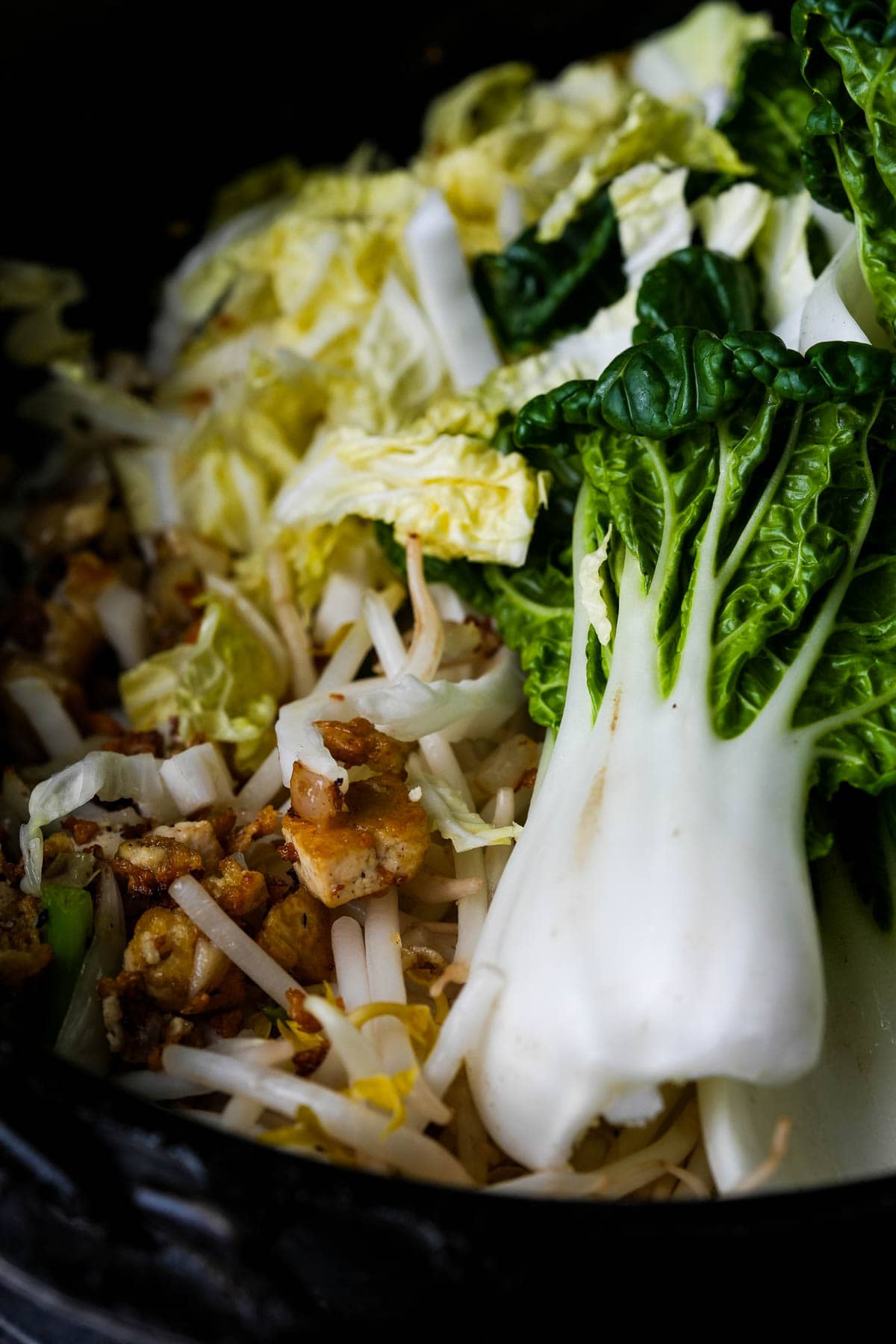
Step Four
Stir in the bean sprouts, baby bok choy, and roughly chopped Napa cabbage. Stir-fry these vegetables for 2-3 minutes, wilting slightly while still retaining their vibrant color and a pleasing hint of crunch.

Step Five
Drain the soaked rice vermicelli, now softened and pliable. Add the noodles to the pan, gently mingling them with the tofu and vegetables using a pair of tongs, ensuring that they absorb the surrounding flavors.
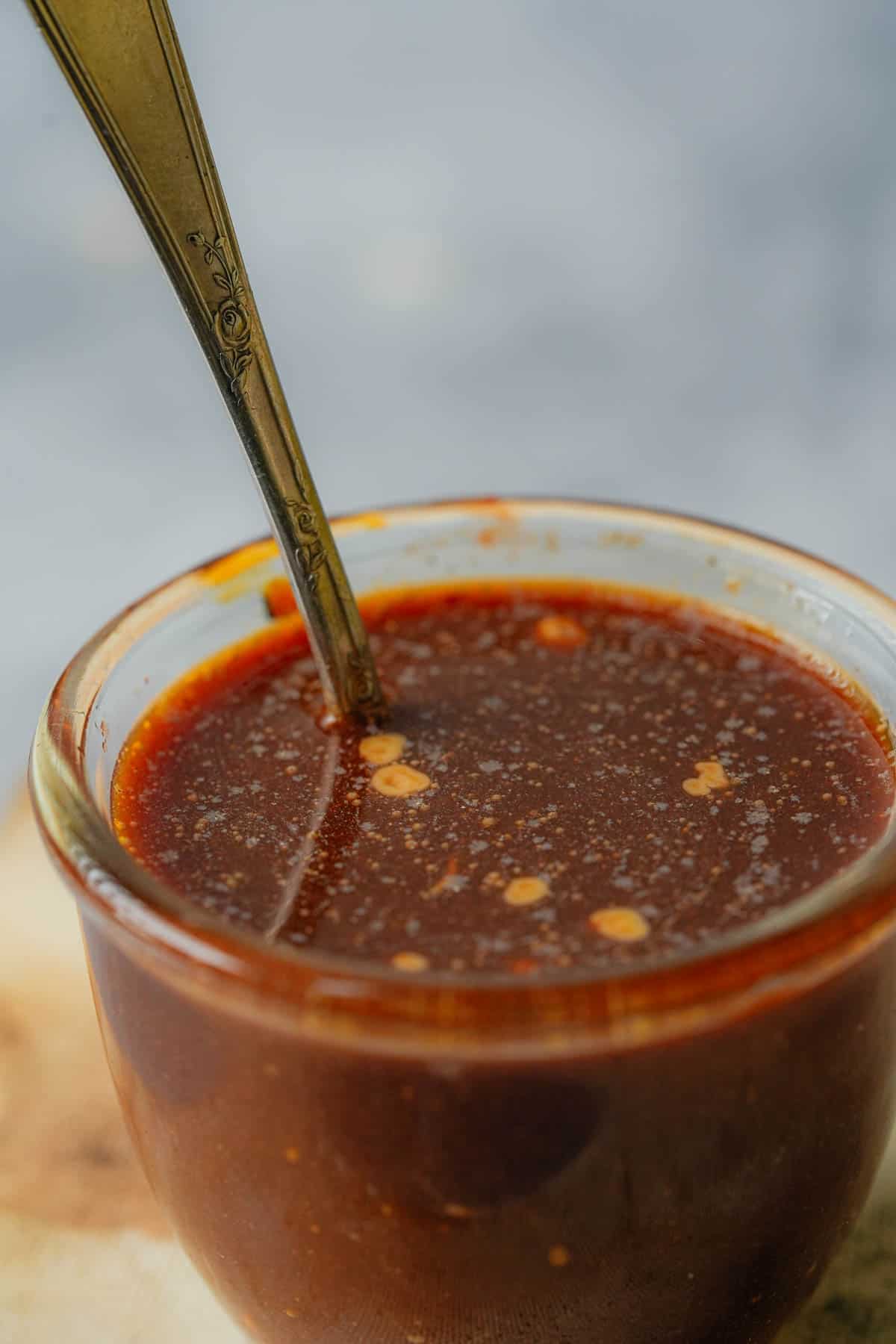
Step Six
In a separate bowl, combine water, sriracha (or sambal oelek), vegetarian oyster sauce, kecap manis, white pepper, and cornstarch. Whisk this concoction diligently until it transforms into a smooth sauce.

Step Seven
Pour the sauce over the stir-fry, ensuring an even distribution that envelops each ingredient. Keep stirring, coating the contents of the pan with the saucy goodness.
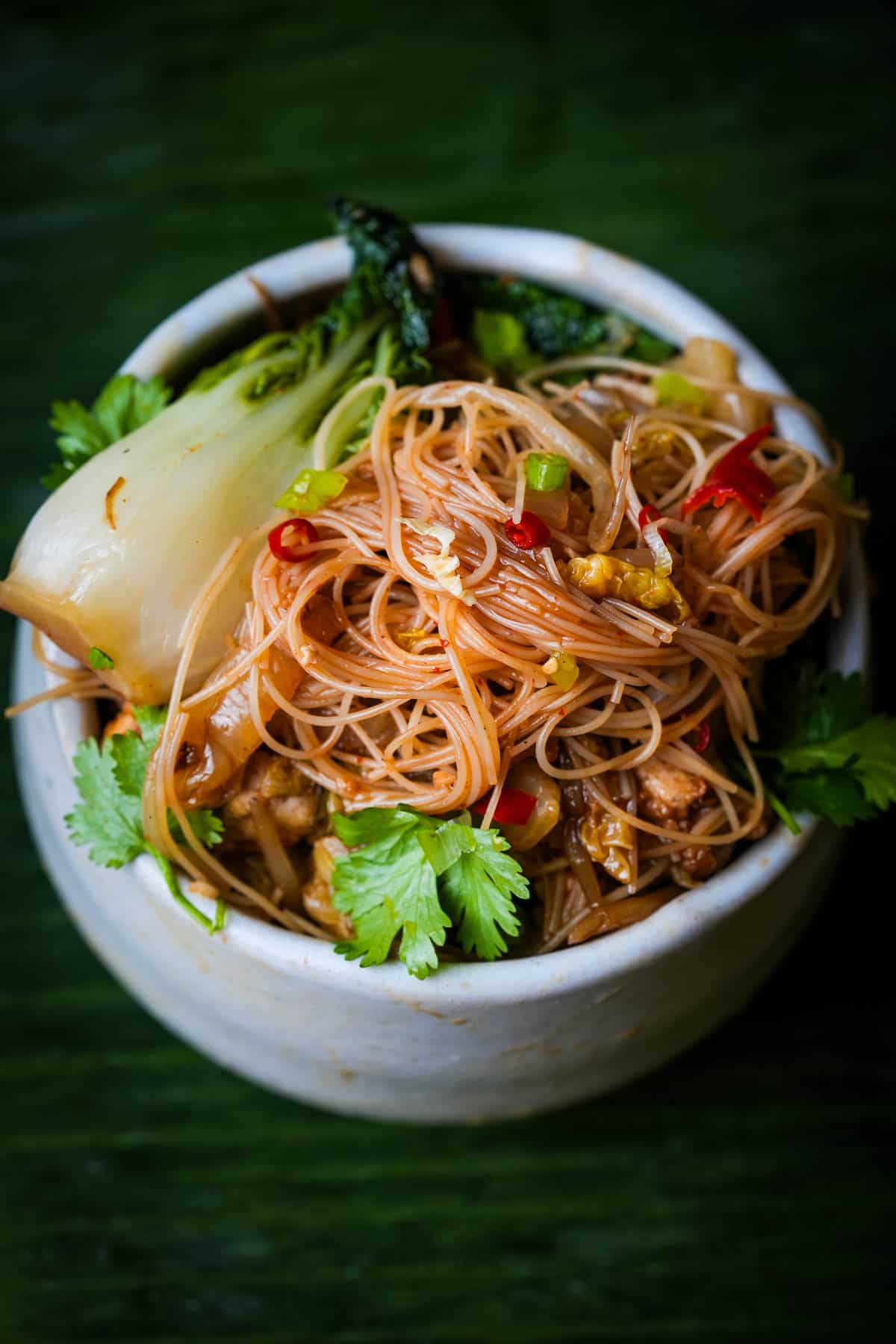
Step Eight
Portion the Bihun Goreng onto serving plates, and garnish with thinly sliced scallions and some sliced bird’s eye chilies (optional). You can top it with some of my homemade vegan chicken grilled in sticky gochujang BBQ marinade if you like!
💡Serving Ideas
Don’t let your poor Bihun Goreng get lonely!
This Singapore fried vermicelli dish goes great with sayur lodeh, a coconut milk-based vegetable stew, or alongside some Filipino vegan dishes like ensaladang talong or tofu sisig.
For more veggies in your life, serve it alongside urap sayur, a vibrant Javanese mixed vegetable salad that you can serve over nasi uduk, nasi minyak, or nasi kunyit – fragrant rice dishes that offer a perfect base for this flavorful freaking symphony.
👉Top tips
- Ensure the rice vermicelli is soaked just right – pliable but not mushy. They can be soaked in warm or cold water, but they rehydrate more quickly if the water is warm. Test by gently tugging a strand; it should bend without breaking. Over-soaking or boiling the noodles will result in overly soft noodles that may disintegrate during stir-frying.
- Use a wok or a wide, deep pan for even heat distribution, and to lessen the splatter and cleanup.
- When adding the sauce, make sure to stir continuously. The cornstarch in the sauce thickens as it heats, creating a luscious coating on the ingredients. Stirring ensures even distribution and prevents clumps.
- Don't skimp on the garnishes – thinly sliced scallions and sliced bird's eye chilies add a nice pop of color and balance the flavor profile with some fresh, uncooked notes. You can also use spicy cucumbers, cilantro, or pickled carrots as garnishes.
- Don’t be a bozo and forget dessert! Kuih dadar, tupig, klepon, martabak, banh flan, or Che Khoai Mon, will close out one of the best noodle meals you have had in a while on a sweet note.
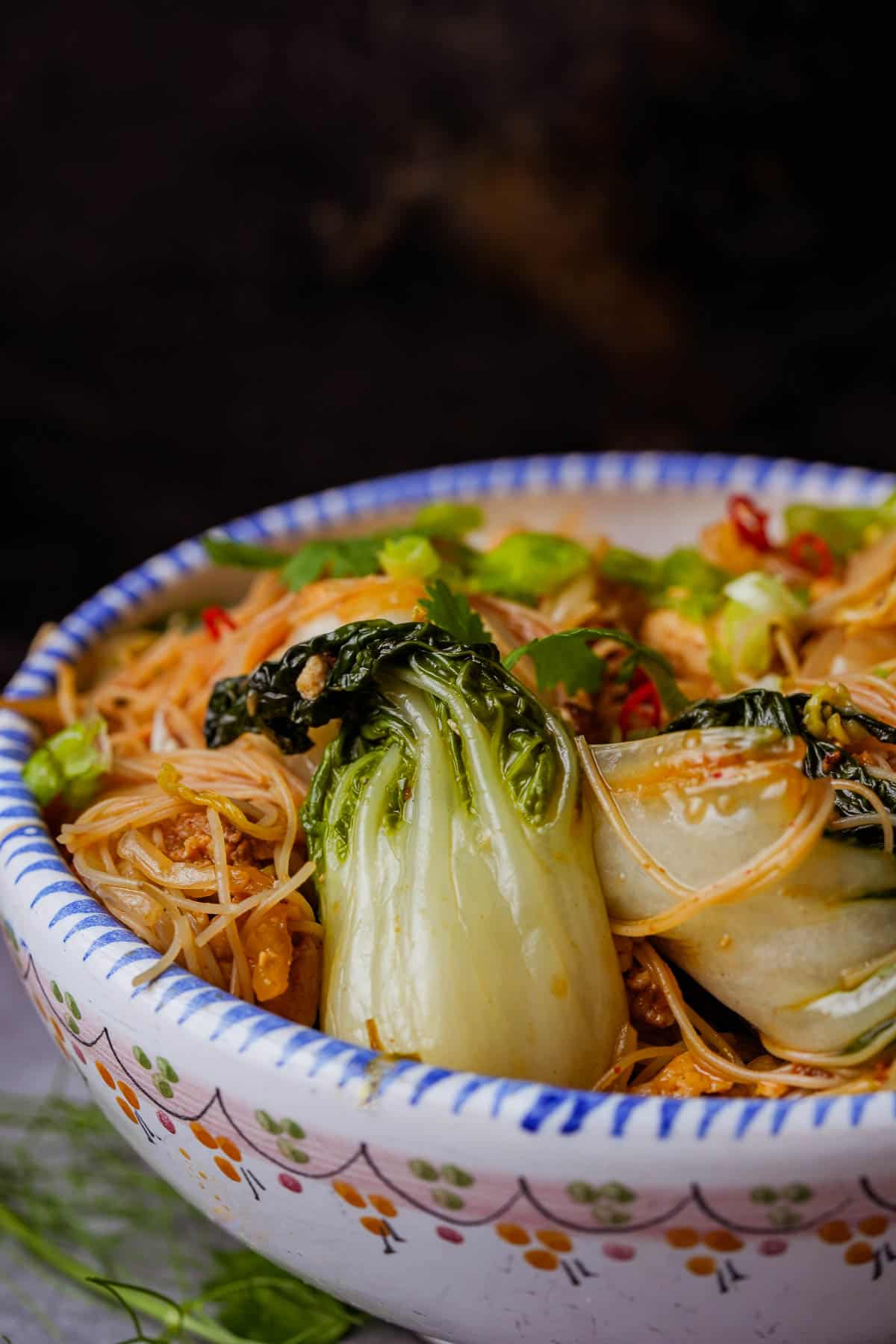
🤷♀️FAQ
Absolutely, adjust the amount of sambal oelek or opt for a milder chili sauce to tone down the heat according to your preference. If you are spice-averse, leave out the bird’s eye chilies from the garnish.
Yes, rice vermicelli is naturally gluten-free. Ensure that your chosen sauces (particularly the kecap manis) and condiments are gluten-free.
🥶 Refrigerate, but don’t ever freeze:
To store your delicious Bihun Goreng, first allow it to cool to room temperature. Place the leftovers in an airtight container and ensure a snug fit to minimize air exposure. Store it in the refrigerator for up to three days.
🔥 Stovetop reheating
Warm a pan over medium heat. Add a small splash of water or vegetable broth to prevent sticking. Gently stir-fry the refrigerated Bihun Goreng, breaking up any clumps, until heated through. This process usually takes about 5-7 minutes, ensuring your meal is piping hot. Add fresh garnishes when you serve the reheated noodles.
☢️ Microwave reheating
Transfer a portion of Bihun Goreng to a microwave-safe dish. Drizzle a bit of water over the noodles to maintain their moisture. Cover the dish with a microwave-safe lid or microwave-safe plate to trap steam. Reheat on medium power for about 2-3 minutes, pausing to stir halfway through.
🍜My faves to serve with this bihun goreng recipe:

Bihun Goreng (Indonesian Stir Fried Rice Vermicelli)
Equipment
- Cooking Utensils (spatula, tongs, etc.)
Ingredients
- 3.5 ounces rice vermicelli a 100 g. bundle
- 3 tablespoons vegetable oil or canola oil, or sunflower oil
- 7 oz. Extra firm tofu (200 g. / half a block) small dice
- 2 scallions cut into 1-inch (2.5 cm.) sections
- 1 medium shallot diced
- 2 cloves garlic minced
- 2 cups
bean sprouts
- 4 baby bok choy or bok choy shoots, leaves separated
- 1 ½ cups Napa cabbage roughly chopped
Sauce
- ⅓ cup water
- 2 tablespoons sriracha or sambal oelek
- 3 tablespoons vegetarian oyster sauce
- 2 tablespoons kecap manis sweet soy sauce
- ½ teaspoon white pepper
- 1 ½ teaspoons cornstarch
Garnish
- Thinly sliced scallions
- Sliced bird’s eye chilies
Instructions
- Start by soaking the thin rice vermicelli in warm water. Allow them to soak as you move through the next steps.
- Heat cooking oil in a wok or Dutch oven over medium-high heat. After 90 seconds, when the oil is hot, add the diced extra firm tofu and fry for about six minutes until it is golden and crispy on all sides.
- Add the diced shallot, scallion sections and minced garlic. Stir-fry with the tofu for a couple of minutes until they become fragrant and slightly softened.
- Stir in the the bean sprouts, baby bok choy, and roughly chopped Napa cabbage into the pan. Stir-fry for around 2-3 minutes until the veggies start to wilt but still retain a bit of their life and crunch.
- Drain the soaked rice vermicelli and add them to the pan with the vegetables and tofu.
- In a bowl, whisk together water, sambal oelek, vegetarian oyster sauce, kecap manis, white pepper, and cornstarch until you have a smooth sauce. Pour this sauce over the stir-fry and stir well to coat all the ingredients evenly. Keep stirring until the sauce thickens and covers everything nicely.
- Transfer the stir-fried rice noodles to serving plates. Garnish with thinly sliced scallions and sliced bird’s eye chilies.
Notes

Enter your email & I'll send it to your inbox. Plus, get great new recipes from me every week!
By submitting this form, you consent to receive emails from Cinnamon Snail.


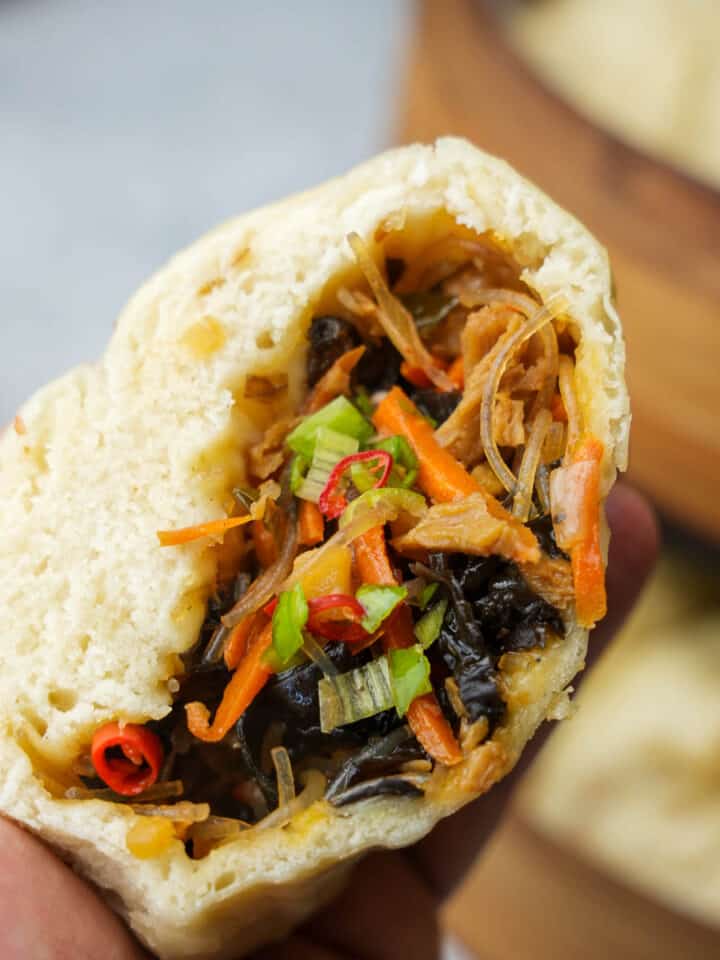

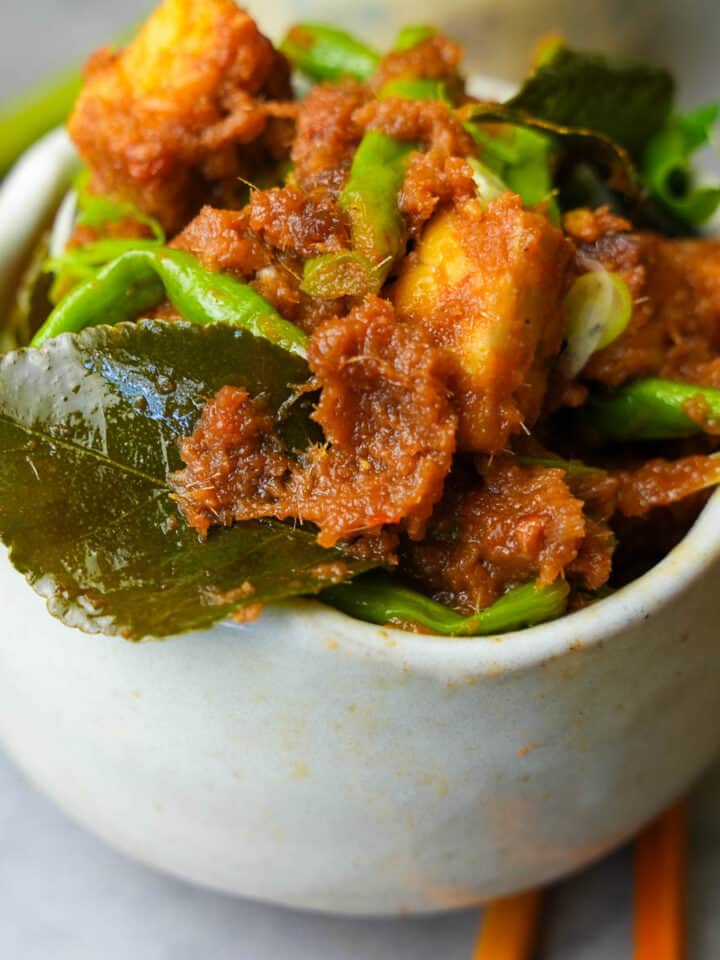






Suzanne says
I made this on the fly tonight since I was able to get bok choy, Napa cabbage, and shallots fresh from the farmers market this morning. Easy to make, delicious. I substituted gochuchang as I had no sriracha.